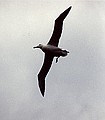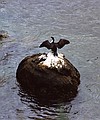New Zealand
|
Dunedin, set on the Eastern coast of New Zealand's South Island, covers the slopes leading down to the end of Otago harbour, a long, dog-legged stretch of water protected from the Pacific ocean by the Otago peninsula. At the seaward end of the peninsula is Taiaroa Head (see left) which is unique in having the only albatross colony in the world on a mainland! The Royal Albatross (right) was circling around the headland on returning from a fishing trip, and eventually landed, neatly folding up its 9 feet of wingspan. |
||
|
The Otago Peninsula is a superb location for wildlife. Below the headland (above left) is a small beach containing a colony of Fur Seals. From a car park, a path (left) leads down the side of the beach, and I noticed an area containing bird droppings. A closer look revealed a small burrow, which belonged to a family of Blue Penguins. The chick (right) was quietly waiting inside the burrow for its parents who would return from the sea at dusk with food. |
||
|
Otago harbour
belonged to shags (left), fishing busily or standing around on suitable
roosts chatting. On the seaward side of the peninsula are remote beaches
visited by the occasional sealion, backed by grassy slopes owned by
Yellow-Eyed Penguin colonies. Rocky points are where Fur Seals congregate,
while there are several inlets containing wide areas of mud flats on
which many waders feed, including the elegant Pied Stilts (right).
|
||
|
South of Dunedin is the Catlins
National Park where we spent a few days at Nugget Point. We visited
McLean Falls, which was memorable for the approach walk through podocarp
forest, so-called after the native trees it contains (rimu, miro and
rata) which bear their fruit on the tips of the twigs. The ferns, particularly
the tree ferns, gave the forest a unique character.
|
||
|
And so to Stewart Island,
1200 square miles of wilderness lying off the bottom of South Island.
As we settled in to our accomodation in Oban, the only village containing
the only roads on the island, we were greeted by the Kakas, parrots
with the usual egregious characters of their kind. They indicated the
bowl on the veranda which needed filling with sugared water, and the
one pictured on the left is kindly pointing out his picture in the bird
identification book!
|
||
|
Another nectar-eating bird which visited us regularly
was the Tui, spruce and formal with their little white bib. They quarrelled
vigorously over the sugared water with each other but sometimes a pair
would cooperate in harrassing a Kaka into abandoning the bowl.
|
||
|
A Stewart Island Shag hanging his wings up to dry -
a bird which fished all around Halfmoon Bay as well as the open sea.
In the forest, the large and colourful New Zealand Wood Pigeon was equally
common.
|
||
|
A number of native New Zealand birds are on the brink
of extinction due to the pressure on their habitat, but particularly
due to predators introduced by man, and the Department of Conservation
has created several predator-free islands by intensive and continued
trapping. One such island is Ulva Island, where three species at risk
have been released in the hope that they can thrive there. As we were
walking through the primeval forest (left), a party of Stewart Island
Robins (right) came fluttering through the trees. They posed for me
at a distance of about two metres, showing the fearlessness and curiosity
that may perhaps be one of the reasons for their near extinction.
|
||
|
Harrold Bay was
a highly atmospheric place, being the site of New Zealand's first European
settlement by Lewis Acker. The hut he lived in was still there, but
the piles for a quay and abandoned fishing gear which contributed to
the atmosphere would have been of later date. The Fur Seal posed on
the sand while half a dozen people admired it.
|
||
|
The ferry returned us to the mainland,
and we set off for Fiordland,
a huge area of mountains, deep valleys and fiords in the southwestern
corner of South Island. You can climb mountains which are next to the
only road through it, or accessible from one of the two walking tracks,
but if you want to climb any other mountain, you need to get to it by
helicopter. The forests covering the mountainsides are mostly of beech,
but covered with ferns and moss.
|
||
|
The mountains are the home of Keas, parrots which have
the character and intelligence of their cousins, but with a hard and
piratical edge. They are accused of stripping the adhesive from car
windows and other acts of vandalism. These Keas were high up by the
Homer Tunnel, through which the road drops down to Milford.
|
||
|
Milford Sound
is one of the most picturesque fiords in Fiordland. After driving through
the mountains and the rain to the village of Milford, we travelled by
boat up the sound, marvelling at the temporary waterfalls spilling over
the edge of sheer walls. As we came to the open sea, the rain stopped,
the clouds lifted and blue sky appeared.
|
||
|
On the way back up the sound, we passed a group of fur
seals basking on a rock, one of the few places where the mountainside
did not disappear into the depths at a near vertical angle. Without
rain, many of the falls which collected their water from bare rock had
stopped, but the most majestic cascades still roared from the mouths
of inaccessible hanging valleys.
|
||
|
Red-Billed Gulls (left), can be found making a living
on beaches and cliffs along the South Island coast, and also ambushing
people with snacks in parks, like their brothers in the Northern hemisphere.
In the fashionable resort of Queenstown, their place was taken by Black-Billed
Gulls, here casting cold blue eyes over a spring roll.
|
||
All text and graphics © Pat Bennett 1996-2002


























